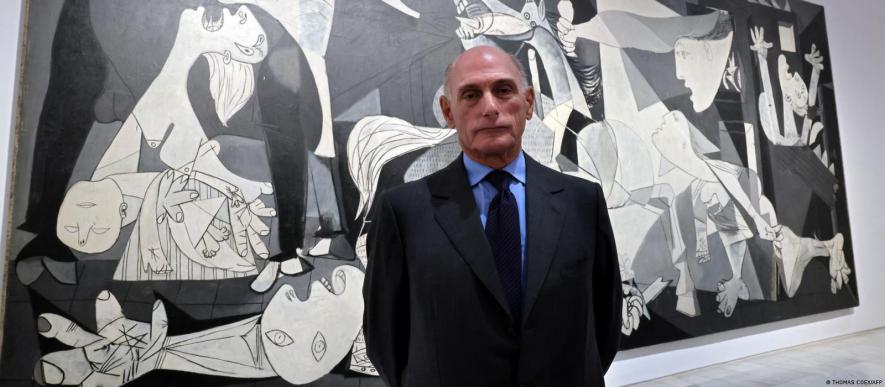Pablo Picasso 'Saw the Joy And Also the Pain of Life'

When artist Pablo Picasso died on April 8, 1973, he left a legacy worth millions — but no will. It took a full seven years to list and catalog all the paintings, sculptures, drawings, prints and texts he had created throughout his life — about 150,000 works. Legal disputes have continued over the ensuing 50 years, but today the largest single collection of his works can be found in the Picasso Museum in Paris.
One of his legal heirs is Bernard Ruiz-Picasso, Picasso's grandson, who was 13 years old at the time of the artist's death. His father, Paulo Ruiz-Picasso, died in 1975. Twenty years ago, Bernard Ruiz-Picasso and his mother donated part of their private collection to found the Picasso Museum in Malaga, Spain — Picasso's birthplace.
DW met the art collector in Paris.
DW: When did you first realize that your grandfather was one of the greatest artistic geniuses of the 20th century?
Bernard Ruiz-Picasso: I realized that he was an important person before his death in 1973.
As a child, I used to visit him in the south of France. He was surrounded by many friends and he had a big house full of art. He was very busy.
I was young, so I did not really notice how important he was on an artistic level, but in his life, I realized that people paid attention to him. He was not treated like a carpenter or an electrician. He was different.

Pablo Picasso, who lived from 1881 to 1973, spent much of his working life in France
How do you remember him? Was he a kind grandfather?
When I was young, times were different. Children weren't allowed to interrupt adults. When I was playing on the floor of the living room and he was talking with other adults, sometimes he asked me to come to sit with him or he showed me something and took me in his arms like grandfathers do.
You founded the Picasso Museum in Malaga 20 years ago. How does this museum commemorate Picasso? And how is the 50th anniversary of his death going to be marked?
In fact, it's a coincidence that we are celebrating the 20th anniversary of the museum in Malaga and the 50th anniversary of Picasso's death.
So we're going to celebrate this institution with an update of where we are, and we'll try to make the museum ready for the future.
Museums and their visitors have changed a lot in the last 20 years. It's a long process, things are slow in a museum, but we are really in a moment where museums around the world are questioning their missions, and we share those questions with other institutions.
Picasso spent his childhood in Malaga. How did these years influence his work?
There is no doubt that for any artist, their early years are highly influential. In Picasso's case, you can really see all the colors of his childhood in his work, how they appear in his paintings: the orange, the yellow, the lemon. The colors of Malaga influenced Picasso a lot.
And his father was a very good artist, specializing in still life, called "Bodegones" in Spanish. He was a teacher at an arts school at Malaga that contributed to many artistic developments in architecture, in design and applied arts. Pablo Picasso, or I should even say his father Pablo Ruiz, had started life surrounded by culture and art.
And as a city, Malaga has changed a lot because of the Picasso Museum and also other art institutions. It has become an artistic town.
Picasso's relationship with women is increasingly criticized today. Why did you once say in an interview that he was a feminist?
That's a quote taken out of context by a French journalist in a Spanish newspaper. But yes, I think the way he portrayed himself, but especially the way he portrayed women — as mothers, as lovers, as terrifying, hysterical characters — that is extraordinary. In this context, an exhibition at the Musee d'Orsay on the Blue and Rose Periods opened my eyes. There I learned to see his works in a new way. These early paintings depicted women who had syphilis or were in prison completely starved. Picasso was always against tyranny and barbarism in all areas.
Did the painting "Guernica" mark his turn as a political artist?
From a very young age, Picasso was engaged with many different groups of people who were fighting to improve their living conditions.
"Guernica" is one example. He painted it as a commission for the Spanish pavilion during the international fair in Paris in 1937. But he also did paintings about the war in Korea and, in the 1940s, he portrayed women who had been mutilated during World War II.
I think he was an artist who was very sensitive, who saw the joy and also the pain of life.
When Picasso died it was difficult to share his estate. You had to give a big part to the French state. How was it sorted out then?
Picasso passed away in 1973. Then my father passed away two years later, unfortunately. And my half sister Marina lost a brother who committed suicide in 1973. All that was pretty sad. So six of us were left: Maya, Paloma, Claude, Jacqueline, Picasso's widow, Marina and I. The lawyers and the French government had created the idea of "dation" — using artworks to pay inheritance tax — which was a very good system. I think it was Georges Pompidou who initiated it in his time as president. So the Picasso Museum in Paris got a beautiful collection. The family also donated his private collection including paintings by Cezanne, Matisse and all the archives. So we gave them a lot of documents which enabled them to reconstruct the life and work of Picasso.
He did a lot of paintings of your grandmother. Do you own some of them?
I own a few things from my grandmother. I worked for 10 years on the translation of my grandmother's Russian correspondence. We organized an exhibition called "Olga and Picasso," in Paris, Moscow, Malaga and Madrid. And we did a lot of research because we had no idea who Olga actually was. It's a sad story from the times of the civil war. She came to Europe as a young ballet dancer in 1911 and met Picasso in 1917. At Picasso's side she led a dreamlike life, almost like a little princess. But while Picasso became increasingly famous toward the end of World War II, she lost her entire family on the other side. They died in the civil war, or in the army.
There are a lot of exhibitions commemorating Picasso in 2023. Are you going to see all of them?
I'm trying to figure out how to be in two places at the same time! No, I'm not going to see all of them. But I want to travel a lot in 2023, because I think it's worth seeing many of them. I think both presidents of France and Spain have had this idea to end this year of celebration at the UNESCO in Paris. This will also be a statement for democracy.
Interview by Sabine Oelze and Susanne Luerweg. This article was originally written in German.
Get the latest reports & analysis with people's perspective on Protests, movements & deep analytical videos, discussions of the current affairs in your Telegram app. Subscribe to NewsClick's Telegram channel & get Real-Time updates on stories, as they get published on our website.
























